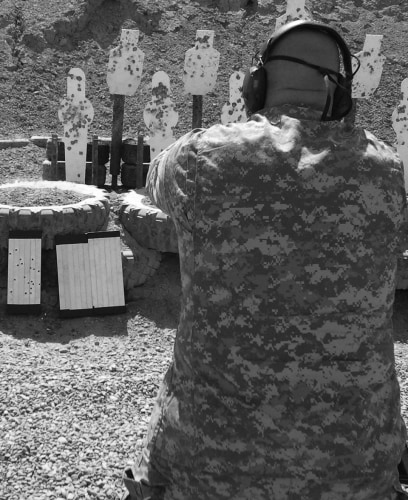
The South is every bit as much a part of Margaret Evangeline's work as, say, a rifle or sheet metal, but the Baton Rouge native is inexplicably unknown in her hometown.
"Margaret is easily one of the best-known artists throughout the country and even the world, but ... her work hasn't received a lot of attention here," said LSU Museum of Art curator Katie Pfohl. "It's a real chance to take an artist who's from here and who has deep connections with Baton Rouge and LSU and show the range of her artistic output."
That chance is a large retrospective exhibition at the LSU Museum of Art. Evangeline's exhibtiion, "On War," opens with a reception March 12 and will remain there through Aug. 2.
On the surface Evangeline's own connection here might not seem obvious. The work she's best known for is the result of her son serving with the Army in Iraq. As a means to connect with him and to explore and understand the facets of how it feels to send a son to war, she shipped sheets of metal to her son and the soldiers he served with, who then shot the pieces before returning them to the States.
Utilizing unexpected and repurposed materials "is just so southern to me, and certainly a big part of my work," Evangeline said. "It comes out of the make-do ethic, I think. It's just that odd and maybe unexpected materials just speak to me, and I use that a lot in my work.
"I like the contradiction of using non-art materials to make art, because I just really feel that if it looks like art, it's not working. It should be a surprise."
Evangeline first formally experimented with her shot-paintings as a residency in Santa Fe as a means of practicality. She was drilling holes into a metal sculpture and thought it might be easier -- and more dramatic -- to shoot them instead. Borrowing a rifle and reigniting the skills her grandfather had once taught her in Ville Platte with a pile of old tin cans, Evangeline created her first shot-paintings.
"The odd thing about shooting tin cans with my grandfather -- I think I was five or maybe even younger -- when I went to pick them up, I thought, 'Oh my God, these are beautiful.' I thought they looked like flowers opening up," Evangeline said.
Through the works, Evangeline said she's come to explore their meaning and context in new ways. When she first saw the metal pieces return from Iraq, for example, she thought they looked like Braille.
"Because Margaret has these strong ties to Baton Rouge and it explores her thinking about war and having a son in war, it was a huge chance to take a global issues at the moment and really bring it home in a way we think will be really compelling for people to see," Pfohl said.
Adding to the visual element will be a new -- and massive -- installation. Evangeline worked with an LSU student of digital media to create a 70-foot-long digital projection along the long gallery wall using a planetarium projector.
Written by Chelsea Brasted